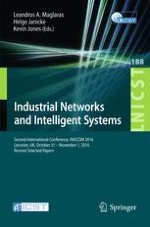2017 | Buch
Industrial Networks and Intelligent Systems
Second International Conference, INISCOM 2016, Leicester, UK, October 31 – November 1, 2016, Proceedings
herausgegeben von: Leandros A. Maglaras, Helge Janicke, Kevin Jones
Verlag: Springer International Publishing
Buchreihe : Lecture Notes of the Institute for Computer Sciences, Social Informatics and Telecommunications Engineering
